An investment grade 1974 Ducati 750SS green frame is becoming harder and harder to find. I work very closely with Ian Falloon and we have both found it tougher each day to find the right example for our customers as they find their way into stronger and stronger hands. Nearly all of them being offered now have some of the unique parts missing which are impossible to find, and if you do find them they can be prohibitively expensive to acquire. It is always best, and most costs effective, to buy an example with all of those components present. Although the green frame shares many components with the 750GT and 750 Sport, most of the unique components are not shared with any other motorcycle at all. Finding such parts will always alert the seller as to which motorcycle they are for, so bargain basement deals won’t be found. A machine with every component correct is known as a full house green frame.
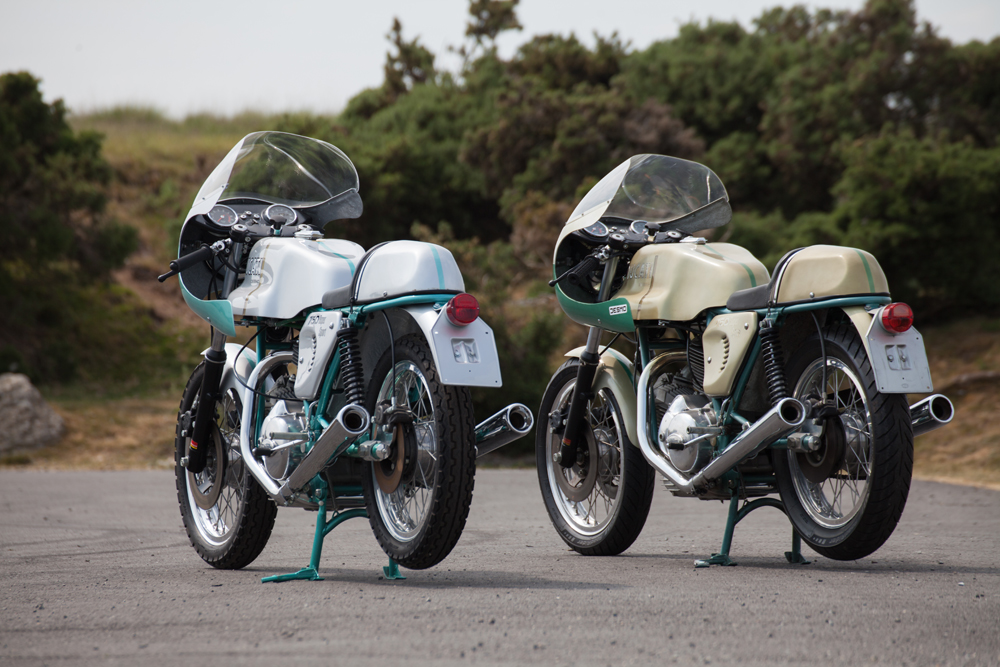
Full house green frame
A full house green frame is now a seriously big ask and sellers know what they have. It’s not just about rims, carbs, headlamps, bodywork, forks and brakes, it’s also about the nuts, bolts and finishes. So many of these machines have not been started for years and assuming the motor is in great condition because you were told so by the seller just isn’t enough, as everything is so expensive to fix on these motorcycles. Engines should be up and running properly, brakes can be very costly too, if not resolved, and they really do need to be the correct components. Thinking you can just pick up these impossible to find unicorn parts means you’ll spend years of frustration and it was just much cheaper to buy a full house example to start with and a lot less heart ache. Usually if parts are missing, as you get to know the motorcycle, more and more little pieces are missing and work was never done correctly in the first place. Chances are that the original owner, who started out with good intentions, hoping to create an investment grade green frame and find parts as they went along, just got bored. After many years of searching, a budget greater than the value of the bike, they usually feel the need to get the thing finished and move it on having learned their lesson. There are plenty of 1974 Ducati 750SS green frames like this doing the rounds. Full house green frames are seriously tough to find and you will need to pay the owner what they want for such an example.

Green frame compromise
There will need to be a green frame compromise due to the scarcity and cost of investment grade examples available. Ian Falloon and I have discussed this at length, and very soon, customers will have to compromise on accepting full house green frames and settle for ones with replica parts. We are already finding ways of replicating certain unicorn parts and we will maintain a register of which machines are genuine and which have replica parts. Customers will just have to get used to paying more for genuine full house green frames and paying an awful lot for the replica parts to ensure that quality is maintained. Making high quality replica parts one at a time is a very expensive process, so it will cost a lot to bring a machine up to spec with replica parts and it will always be known that the parts are replica on it through the registry. This means that original full house green frame prices must increase, as they are of greater value than the ones with replica parts. There are just not enough full house machines to go round and the new export markets are extremely hungry for the highest quality investment grade classic motorcycles.
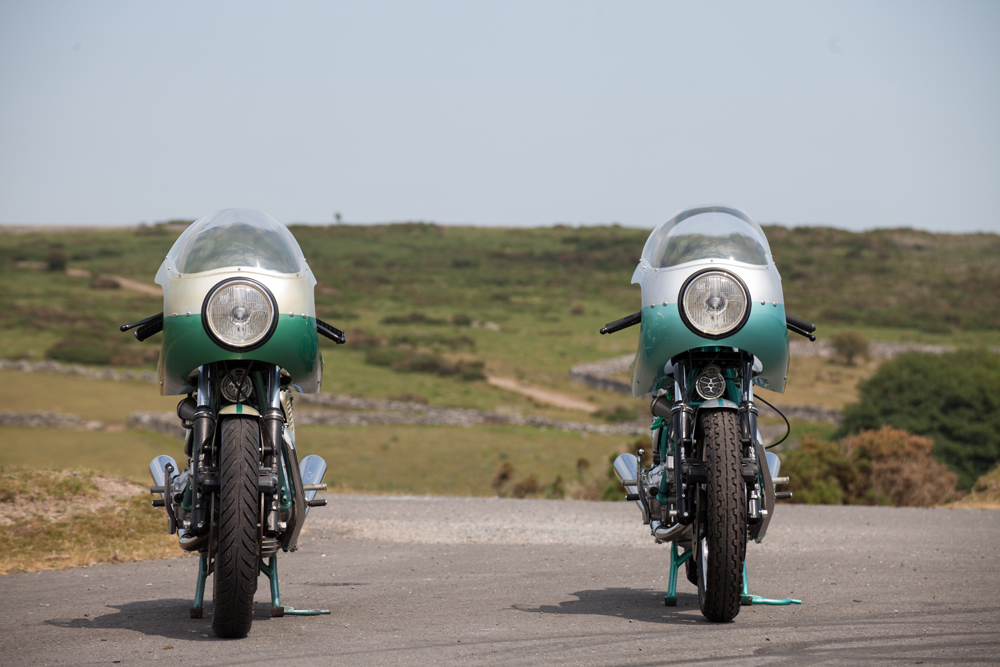
Better to ride them
It is better to ride them than park them up, as all of these motors are really suffering from lack of use. The longer these machines are not run, the more expensive it is to bring them back to life and riding them really does keep them in good condition. Owners often worry that running up mileage will devalue their motorcycle, but this is not the case. These motors are fine for 100,000 miles between full rebuilds, so riding them 1,000 miles a year will take 100 years before a full rebuild is required. Using the machine in such a way will keep them in great condition and less vulnerable to component failure. This idea of motorcycles having to be low mileage, or under 5,000 miles, comes from British motorcycle ownership. Most of the British machines, not Broughs or Vincents, need the valve guides replaced every 5,000 miles which is where this myth comes from. None of this applies to modern Italian and Japanese motors at all, it’s a redundant ideal. When motors are treated with respect, allowed to reach operating temperature gently, then put under load they are far more reliable than if they’re hardly ever used or just laid up for decades on end. You can see videos of some of the work we had to do to the Amelia Island green frame which had been laid up for twenty five years on our Youtube playlist. The time is coming where classic motorcycles which are not run will have a lesser value than those which are run.
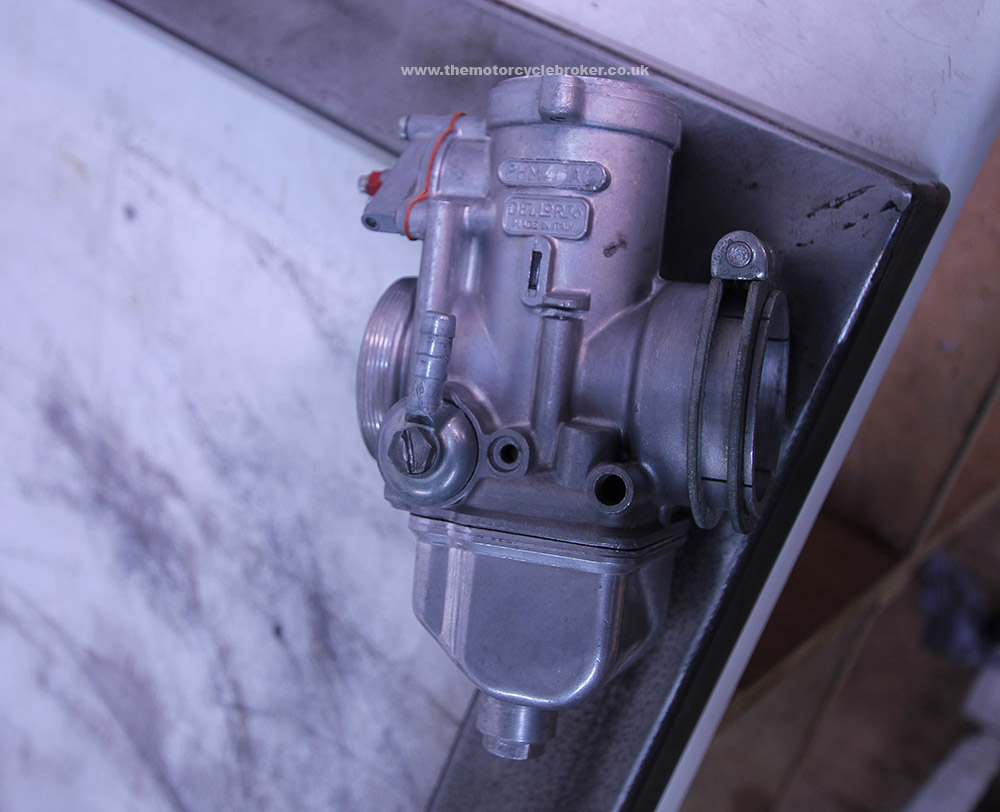
Green frame paint
Green frame paint is an extremely complicated issue with conflicting information everywhere. We are very fortunate to have been working on the Amelia Island green frame which has 5,000 miles from new and is mostly unrestored. The owner wanted us to retire the bodywork, while it still has integrity, and to completely reproduce the patina using modern paints on replica bodywork. This is a very wise move which adds great value to their motorcycle while preserving and conserving the original paintwork and bodywork. We have spent a few months trying to recreate the silver and turquoise of the bodywork and the frame. We could not charge for over half the work we did, as it would just be way too costly and we have spent many, many months researching paint. One thing we learned was that the lacquer had a yellow tinge to it from new, compared to modern clear coats, which may have been due to the UV protection additive. As the bodywork ages it yellows more and more. To create the silver we could not use any modern silver as they just don’t look anything like this stuff from 1974. We had to make the colour from scratch and getting as close as we have has been seriously challenging, with making up over two hundred examples of different colours to get just the silver right. The turquoise was also tough to make, but we managed that a little easier than the silver. What we have recreated is a match for this particular motorcycle at this moment in time, taking into account the ageing of the original paint. To do so we had to create the paint prior to ageing and then create the ageing process in paint using a candy.
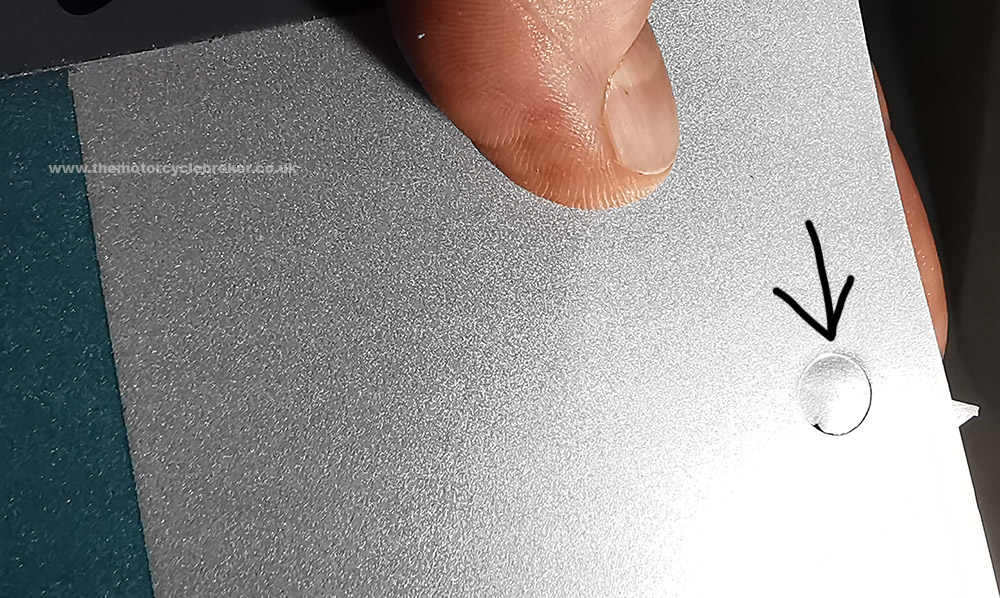
All green frames are a different colour
All green frames are a different colour all over, although they used the same or similar paint throughout production. The paint will vary significantly depending on what carrier was used, whether it was cellulose, thermo plastic acrylic, two pack, or synthetic enamel. We will know shortly what was used as the paint is being analysed in a laboratory, so we found some original paint and have taken samples. Rather than remove original paint from the bodywork, we got extremely lucky with the fairing, as we knew it had been repainted prior to buying the bike. We manually stripped the new paint back, got to another layer of black paint, another layer of primer and then we hit the original paint. We stripped back the layers taking large pieces of lacquer, silver and blue from beneath the lacquer and we have matched to these samples. This has also given us the samples we can send to the lab to be analysed to understand what the paint was that Ducati used for these incredible motorcycles. We will only be able to state that we have a match for one of the four hundred and one machines built, as each one of these machines will always vary significantly due to how metallic paint works. Moreover, the same colour in the same paint carrier will vary hugely depending on the humidity in the spray booth, gun pressure, gun fan, which spray gun is used, how quickly or slowly the paint is applied, how thin the paint is and how heavily the paint is applied. Each of these factors will change the colour, the way the metallic lies and the depth of the paint, especially with the silver and metallic turquoise. Every one of these machines will have varied in colour and the metallic would have varied greatly too, which itself also affects the colour. They would have looked similar, yet very different in different light and each one unique. What we have achieved is an authentic match to one particular example before the lacquer was applied. We know roughly how much the original lacquer had a yellow tinge to it from the lacquer when new and we know exactly how much further the paint yellowed over the last few decades from the original paint on the original bodywork.
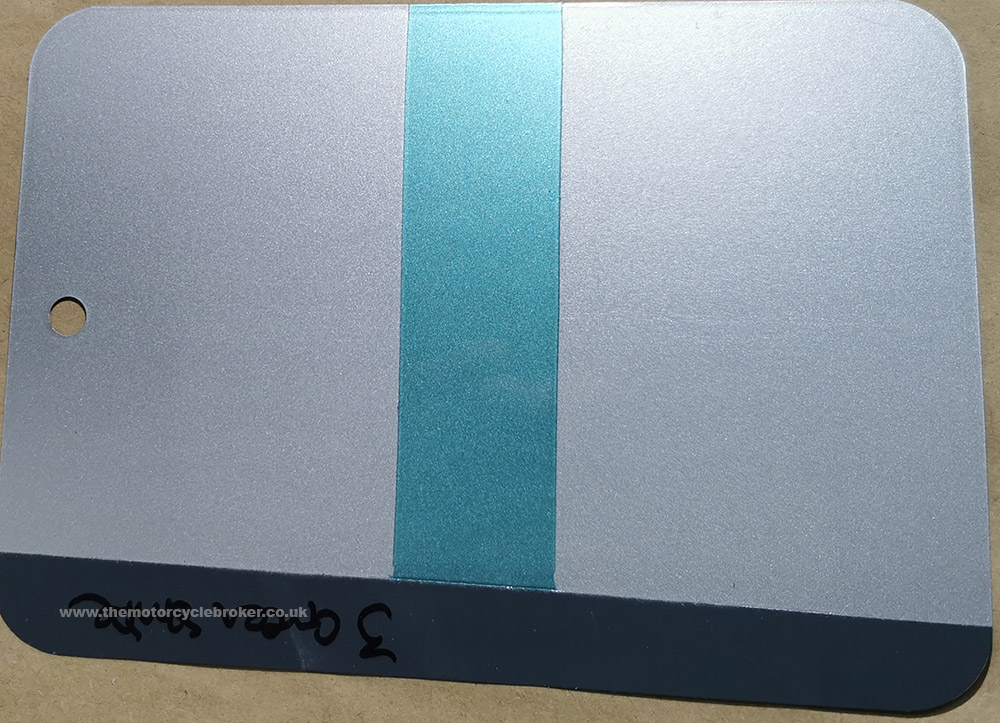
Buying a restored green frame
When buying a restored green frame it is extremely likely that the entire motorcycle will need respraying as modern paints do not look anything like these old paints without some extreme work to recreate the colour correctly. Green frames do have a very particular look with their paintwork and it really makes a big difference to the authenticity of the motorcycle. Over time the finish will become more and more important, in fact we are even respraying a restored green frame we bought for a customer at our own expense. Unfortunately the colours are just not convincing enough. also the filler they used has started to sink, there are lots of inclusions, it’s way too shiny and some of the paint is already de-laminating. This is way below our standards and we ensure machines we supply as investment grade are brought up to standard, included in the purchase price, when you buy an investment grade green frame from The Motorcycle Broker. The bike looked great in the photos, the bike had been authenticated as having excellent paint and colour by a third party. Once it arrived, it is just not authentic enough for our standards even though this one was praised and won shows. Now that the colour has really been scrutinised there are no excuses any more for these motorcycles to have inauthentic paint. We are not being over zealous with our standards, we are taking our lead from the classic car market and how the Concours events work at Pebble Beach through our associates there. These standards always filter down to the classic motorcycle market and we have won Concours events because of such attention to detail. If you’re investing in a green frame, we believe our customers need to be ahead of the curve and to understand exactly what they’re buying and what they own. We will be writing further articles with links to evidence about these trends soon.
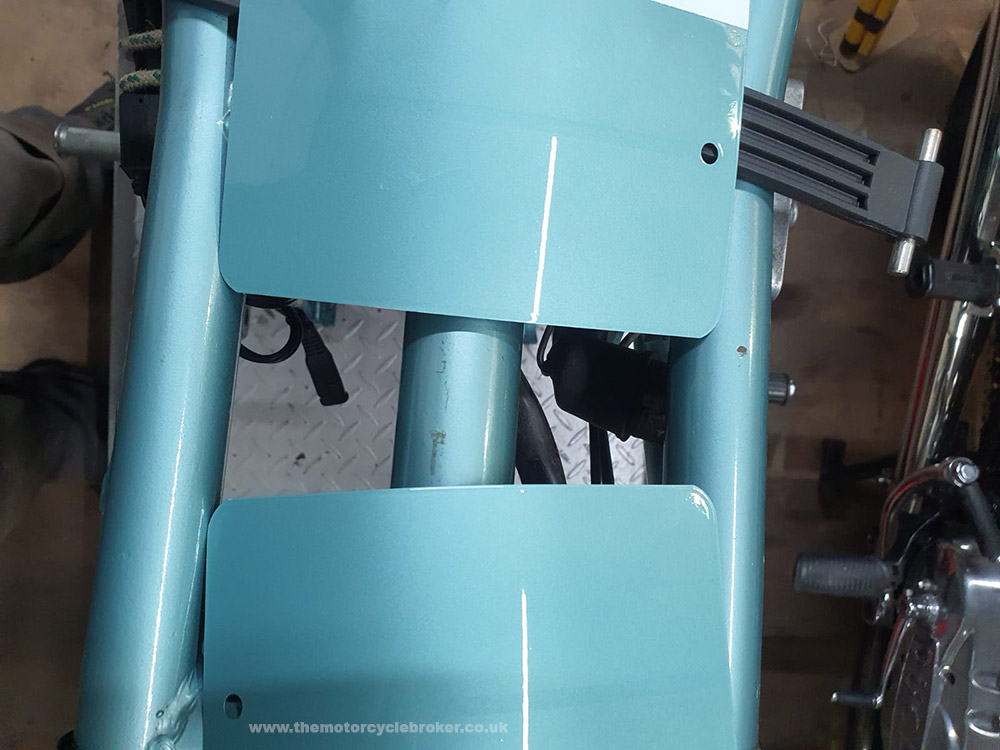
Frame is not green
The frame is not green on a green frame, so if you’re buying a restored example and the frame is green, then the colour is wrong. It was a metallic blue used for Ducati’s outboard motors called Azure Blue (sky blue). Recreating these metallics with modern paints is almost impossible, but with a lot research, colour match attempts, and hard work it is possible to get very close indeed, and it may be that what we’ve created is spot on. The reason we have to be a little vague is that the original paint has aged and will have slightly lost some of its brightness and metallic sparkle. However, the metallics were incredibly flat and had very little flop in this period in history. By flop, we mean the colour you see in a modern metallic when looking face on is lighter than the colour you see when you look across the colour rather than directly face on. When the silver or blue are viewed on a curved surface, the flop is really noticeable. The lacquer is also crazed on the old paint which refracts the light and kills off some of the brightness of the colour and sparkle of the metallic particles, which are small pieces of aluminium. So we recreate the level of metallic we can see, match the aged colour and reduce the flop, all of which sounds simple. However each process changes the colour, so we then have to get the colour back to where it was prior to adjusting it. Once we have achieved a match to the aged paint, then we need to add a little metallic and slightly lighten the colour to match it to the samples of original paint which had de-laminated from the original lacquer. Again, each process changes the colour so everything you do will have an affect you don’t want and this really is a complex process. Any green frame with a green frame is certain to have been incorrectly painted. Even the green on the fibreglass bodywork was never originally green, it was the frame paint sprayed very thinly over the silver. The original lacquer already had a light yellow tinge which turns the turquoise a little more green on the bodywork but it is still clearly a turquoise blue colour.
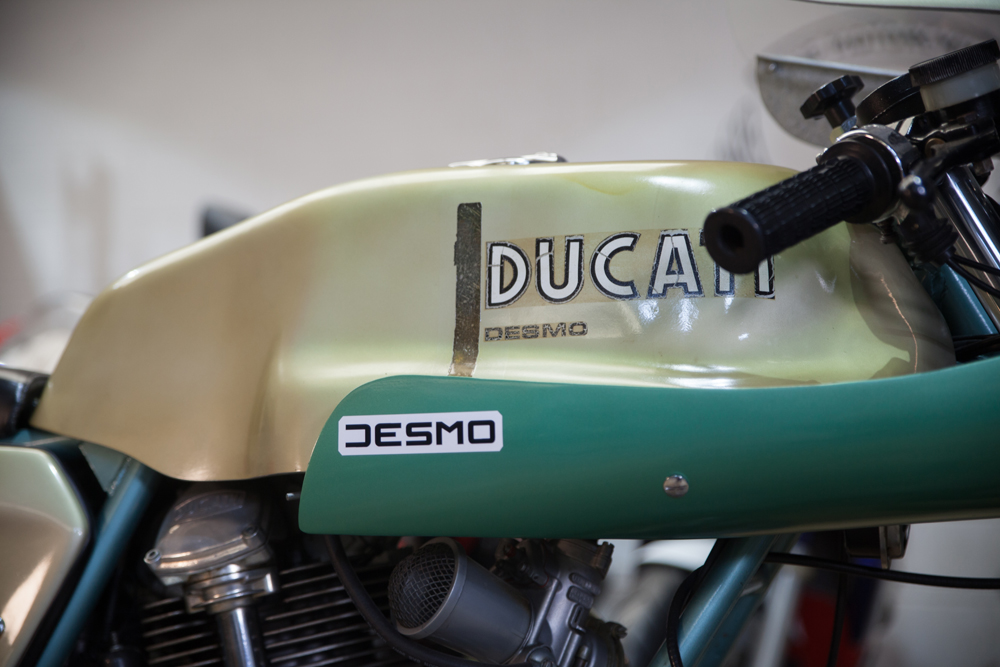
Investment grade 1974 Ducati 750SS green frame
An investment grade 1974 Ducati 750SS green frame is becoming extremely hard to find now, and has been becoming harder and harder over the last ten years or so. Such examples are now in very strong hands and buyers have to pay what sellers want for them, not what they think they want to pay or they’ll have to settle for a compromise. There is a lot to understand about these machines and it’s best to take them to workshops that really do understand them, as they were all hand built and there’s a lot to know. When working on these motorcycles everything takes longer because there is absolutely no room at all for error and all of them suffer from unique anomalies. The first two hundred bikes are believed to have had the camshafts incorrectly drilled which put the valve timing out by up to sixteen degrees. This needs properly checking and if this problem is found it will be necessary to re-time the motor correctly. Old oil turns to a very hard varnish which blocks up oil ways and some machines from new had oil ways incorrectly drilled. The cylinder heads are very crowded and everything is very close to everything else. When certain parts are drilled it is very common for one of the components to have been drilled just a millimetre or so off target which can cause oil ways to have been drilled through or other problems. These issues need dealing with now as it will only become more expensive to do this later on. Once these machines are resolved and set up correctly, they are great bikes and very reliable if they are maintained correctly. If you want an investment grade 1974 Ducati 750SS green frame, contact The Motorcycle Broker through our contact page, or through the form below.
- Most collectible Ducati 916 SP - June 20, 2024
- Classic Motorcycles: To ride or not to ride? - June 17, 2024
- Classic Motorcycles: To ride or not to ride? - June 17, 2024




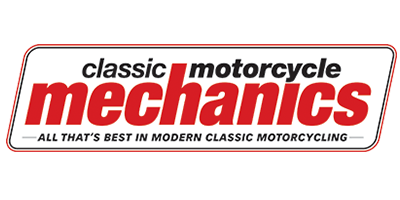



Leave a Reply